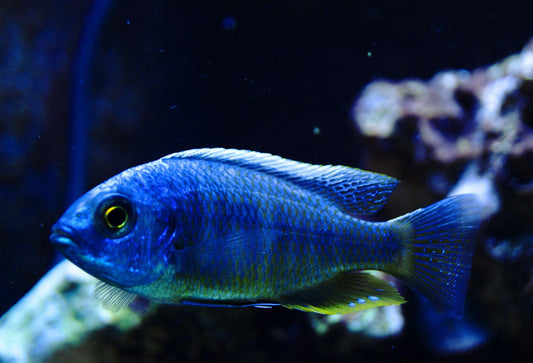Lake Malawi Cichlids
Lake Malawi Cichlids come from one of the oldest and largest lakes of the world. Known for the clarity of its waters and the fascinating number of fish species that it hosts. It is estimated that it hosts around 1000 species of fish species, only a third of which is scientifically described and catalogued. Apart from 44 fish species which belong to other families, all the rest are cichlids. More than 99% of these species are endemic to the lake, meaning that they can’t be found anywhere else in the world.
Mbunas are rock dwelling african cichlids that inhabit the rocky shores of the lake. The group consists of ten genera: Pseudotropheus, Melanochromis, Labidochromis, Petrotilapia, Cynotilapia, Cyathochromis, Genyochromis, Gephyrochromis, Iodotropheus and Labeotropheus. These cichlids normally live in groups but are not considered schooling fish and are quite territorial, especially during the breeding season. Their aggressiveness is usually towards conspecifics, i.e. similar fish, and can be regulated either by providing food several times during the day or by overcrowding the fish tank.
This technique rather distributes the aggressiveness of the dominant males to several males and needs caution. The water needs to be changed regularly. The female to male ratio has to be maintained to a minimum of 2:1. Creating a rocky habitat within the aquarium is extremely important.
Mbunas, like most lake malawi cichlids, are mouthbrooders and require space for their breeding behavior. Lastly, Mbunas are mainly herbivores and possess a short body allowing them to navigate among rocks. They also have a mouth designed to scrape algae from rocks and a long digestive system that allows them to digest their food. They occasionally feed on shrimp and other animals and thus small portions of animal protein can be beneficial. However large amounts of such prey might cause blockage in their digestive system. This leads to a disease known as Malawi Bloat.
https://www.sanctuarycichlids.com/collections/mbuna-cichlids-lakemalawi
Haps and Peacocks are the larger species of lake malawi cichlids which are either sand dwellers or open water fish. The group is composed by more than 20 genera which form the majority of the Lake Malawi Cichlids and include the famous genera Haplochromis, Aulonocara (peacock cichlids), Copadichromis (Utaka Cichlids). They are predators, eating smaller fish and invertebrates. They also eat smaller cichlids, thus choosing their tank mates carefully is crucial as they might feed on smaller species. They are moderately aggressive but are quite large species, requiring large tanks of at least 55 gallons.
https://www.sanctuarycichlids.com/collections/peacock-cichlid-aulonocara
https://www.sanctuarycichlids.com/collections/haplochromis-predatorhaps
Soft substrate is generally more preferable for these species as rocks might constrict space for large growing haps and can cause injuries. Haps are polygamous, with male individuals forming harems of several females, thus keeping a high ratio of female to male species will encourage the formation of small schools in the aquarium. This group includes some of the most famous cichlids such as the Electric Blue cichlid (Sciaenochromis fryeri).
Lake Malawi Cichlids require warm water, between 76 and 82° F and an alkaline pH around 7.8-8.6. Hardness should also be maintained around 4-6 dH. Mixing species of the two cichlid groups from Lake Malawi is possible, however extreme care should be given in order to avoid extreme aggressiveness of mbunas, predation of large haps to other cichlids and crossbreeding of species.
https://www.sanctuarycichlids.com/products/seachem-malawi-victoria-buffer
for more information:
http://cichlidszone.com/lake-malawi-cichlids









